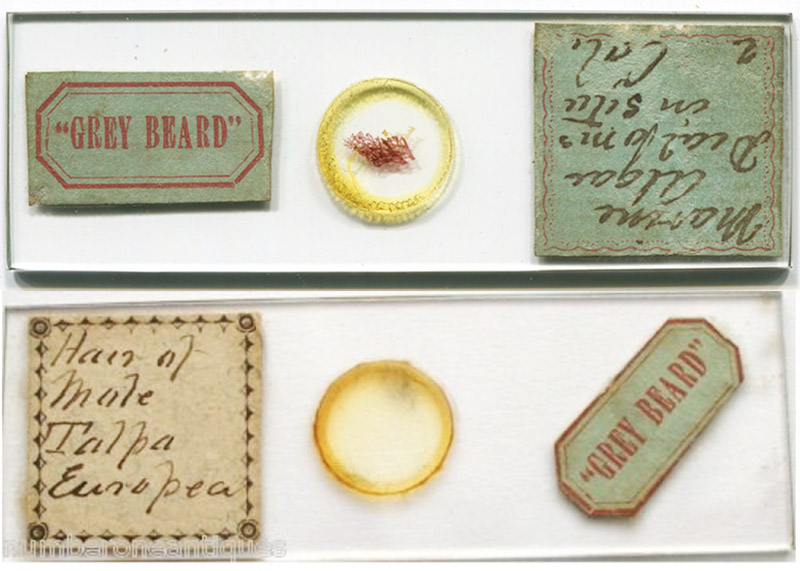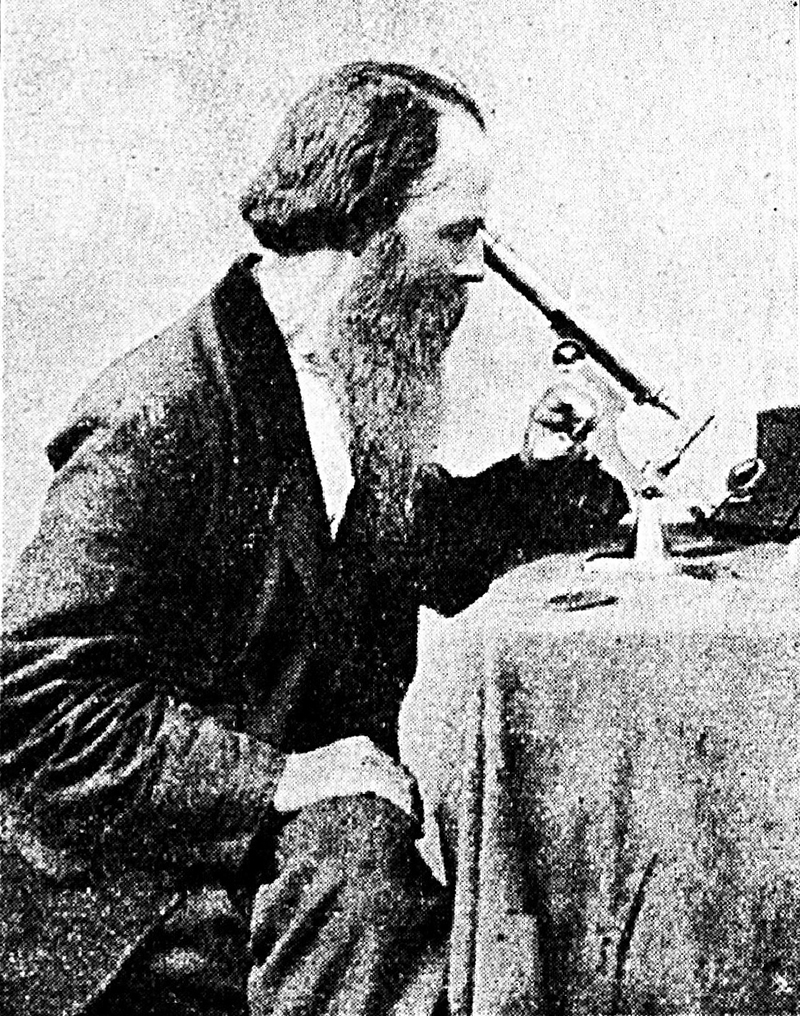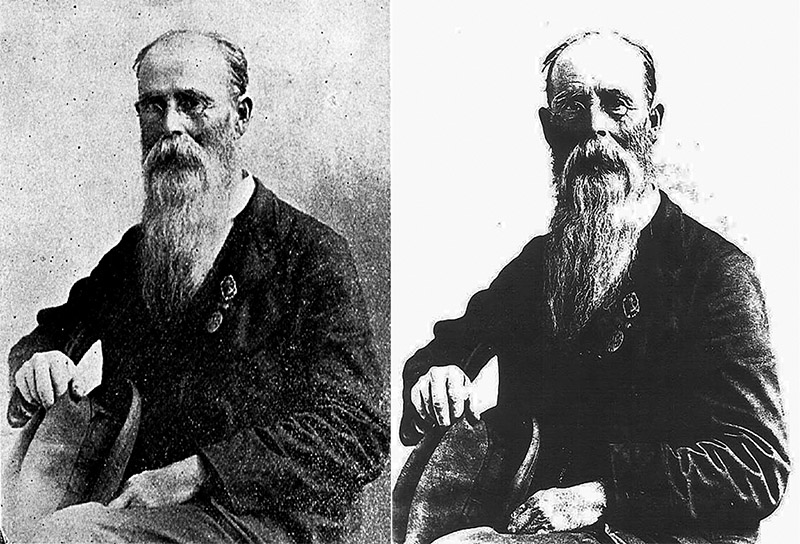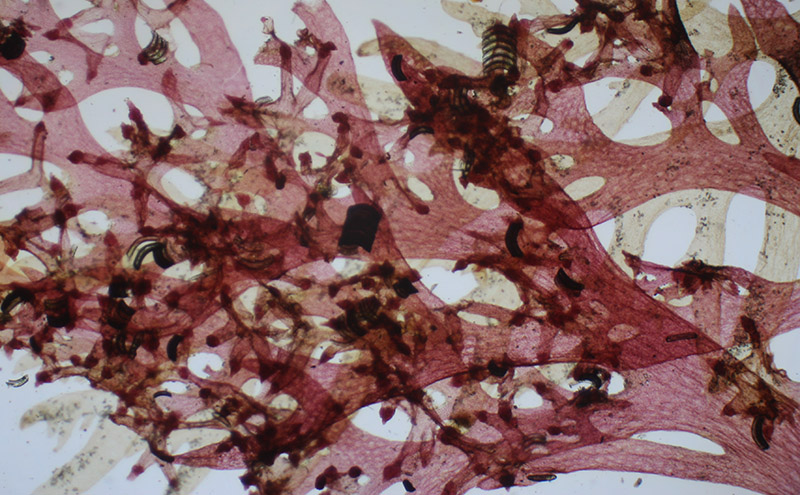
Figure 1. Microscope slides by G.C. Taylor – Marine algae with diatoms in situ, and Hair of mole Talpa europea.
George Creed Taylor ("Grey Beard"), 1824-1908
by Brian Stevenson
last updated November, 2016
George Taylor was widely recognized in the United States and Europe as an expert microscopist, microbiologist, and chemist. He published numerous articles on microscopy during the last quarter of the nineteenth century, mostly under the nom de plume “Grey Beard”. Those publications mixed expert advice with self-deprecating humor, often signed with the address “from the swamps of Louisiana”. A typical Grey Beard article began with, “ ‘Don’t I write too much for my health, doctor?’ ‘No, but, perhaps, you do for your reputation’. Well, since I am not writing for reputation, and as the doctor strongly intimates that there is no danger of my expending sufficient brain force to impair my health, I venture an opinion about two recent books on the microscope, taking them in the order they come from the press, hoping to point out to some one a smoother and less expensive path to the instrument than the ones I have traveled”.
Taylor was initially a teacher, then a planter and refiner of sugar cane. He made an important contribution to the sugar industry in 1892, with identification of the bacterium Leukonostoc mesenterioides, a significant impediment to sugar refining. After several bad years for the sugar business, during the early 1900s, Taylor hit the road to lecture on microscopy. He then retired to his son’s home in Oklahoma.
Taylor also produced a number of permanent microscope slides, labeled with his pseudonym (Figure 1). Grey Beard’s slides are of good quality, and should be welcome in any collection. In recent years, they have been seen at auction on both sides of the Atlantic, suggesting that Taylor sent slides to colleagues in England during his lifetime.

Figure 1.
Microscope slides by G.C. Taylor – Marine algae with diatoms in situ, and Hair of mole Talpa europea.

Figure 2.
George Taylor at work with one of his microscopes. It is a Zentmayer “American Histological” (also known as the “American Columbian”), which was manufactured between 1876 and the mid-1890s. This photograph was included in Taylor’s 1906 memoir “First Steps in Life”.
George Creed Taylor born on August 6, 1824, in Saxtons River, Vermont, to Sereno and Mary Emerson Creed Taylor. In 1832, the family moved to Sparta, Georgia, where Sereno opened The Female Model School, to provide girls with “the highest training and culture of music, painting, domestic home culture etc.”
George was also enrolled in his father’s school, evidently the only boy in his classes. The school gave him open access to chemical and scientific apparatus, which helped shape his curiosity in biology, chemistry, and physics. This almost ended in tragedy at age 12, when he was involved with a hydrogen explosion that severely damaged his eyes. He evidently recovered from the trauma.
In 1839, George’s father gave up presidency of the Sparta school, and opened a new one in Fort Gaines, Georgia. Shortly afterwards, he moved the school to Glenville, Alabama. Fifteen year-old George was given charge of a primary class, in addition to his own studies. With the exception of a three-month stint during 1841 as a teacher in Abbieville, Alabama, he continued to work for at his father’s school.
Taylor’s memoir recalls an incident from 1844 that reflects the culture in which he grew up. He and a school administrator had to deal with a misbehaving 15 year-old student, who was given “punishment which was light”. However, “the family was rich and made a great hubbub about it … After a few days we were confronted by them with clubs and pistols. I received a heavy blow on left breast just as I was falling I grabbed him by the right collar drawing a self-cocking pistol and pointed it at his heart but instantly lowered it to his thigh intending to cripple him that he might have one more chance for life. He was trying to cock his pistol as he fell. His brother made two shots at me one ball passing to the rights and one to the left of my head”. Taylor decided to go west for a while, until things cooled down. He travelled through Mississippi and Tennessee, working occasionally as tutor or as a repairer of pianos and organs.
George married his long-time sweetheart, Hetty Matilda Cropp, on August 31, 1845, in Barbour County, Alabama. They moved to Mississippi, where George resumed a private tutoring position. Successive teaching positions followed, at schools in Selma, Marion, and Dayton, Alabama. In 1850, George began teaching in Madison, Georgia. He later wrote of this time, “I was well known as a teacher of music, drawing, and painting … I have never pretended to be a learned scholar … I have been a hard student of physical science and still am.” In 1856, he opened a school in Fort Valley, Georgia. His business partner forced him out just before the school opened. Taylor attempted to run another school in competition, but ended up leaving Macon.
His wife, Hetty, died of typhoid fever on February 26, 1858, at her parent’s home in Russell County, Alabama. Taylor noted that they had “buried a little boy one year old when … in Madison, and a little girl of two years in Ft. Valley, Ga.” Seven additional children, with Hetty and his second wife, lived to adulthood.
Taylor moved to Summit, Mississippi, and took up farming. There, he married Alice Cross on September 30, 1862. Alice was 19 years his junior.
Just before the US Civil War (1861-1865), Taylor invented a three-barrel revolving cannon. Its efficacy is not known, as the sole example spent the war in a disassembled state in a box on Taylor’s farm.
After the war, Taylor opened a school for boys and girls, in Summit.
At a point between 1870 and 1873, Taylor closed his school, moved to Louisiana, and began farming sugar cane. George’s memoir states, “for fifteen years, under the name of Taylor & Co. I was manager and half owner of Orange Grove Sugar Plantation near Thibodeaux, La Fourche Parish, Louisiana. I grew field cane and manufactured first class open kettle sugar”. He also wrote that from 1882 until 1904, he was an “analyst of sugar cane and its products. The rest of my time was engaged in microscopic research”.
Alice Taylor died on May 17, 1880.
It was during Taylor’s cane farming days that he became a noted authority in the use of microscopes. A colleague wrote, “He has had an extensive experience with the sugar industry of Louisiana, both from its practical and scientific sides. He has been from choice a sugar planter, and while engaged in this pursuit has industrially followed the scientific side of the microscope, polariscope and chemical aids”.
An example of Taylor’s renown is shown in an 1881 advertisement for the book How to See with the Microscope. George’s testimonial was described as being “From the well-known Microscopist, Geo. C. Taylor, Esq.”.
Taylor joined the American Society of Microscopists in 1881. He was elected as a Vice President in 1882. He later became a member of the American Microscopical Society, in 1899.
During 1885, Taylor donated to Tulane University a “set of microscope slides, showing mummy cloth and textile fibers”. His memoir includes a reprint of a paper describing those cloth fibers, as being “Fibre of cloth in which Got-Thothi-Aunkh was embalmed”. This and another Egyptian mummy were owned by the university, but later neglected. They were rediscovered in 1980, in a storeroom inside the Tulane football stadium.
“Time and again have the sugar makers of this State found in their work aggregations of structureless, translucent, jellylike masses which they have called gum”. Investigations by George Taylor, published in 1892, revealed this “gum” to be the product of the Gram positive bacterium Leukonostoc mesenterioides. Taylor’s studies led to methods to control the contaminant.
On May 5, 1893, LaGrange College, of Hannibal, Missouri, conferred George Taylor with an honorary Doctor of Laws degree, “in consideration of your high attainments in science and your diligent study to promote through science the best interests of mankind. You are authorized to use this title, and your name will be enrolled with the names of other honorable gentlemen who have been remembered by this institution”. From that time onward, Taylor included the honorific “LL.D.” in publications.
He presented a lecture on “Sugar and other sweets” at the 1901 Columbian Exposition in Chicago.
As noted above, Taylor left his sugar plantation during the early 1900s. The 1902 membership roll of the American Microscopical Society placed him in Louisiana, whereas the 1904 list placed him with his son in Oklahoma City, Oklahoma. George Taylor died there on May 9, 1908.
Some of George’s thoughts on the microscope:
“From AD 1850 … the microscope has found me a constant companion through all its improvements up to date. The Bible, a microscope, and some musical instrument should be in every family of the land”.
“Years ago I commenced a desire for a microscope. About that time the papers were teeming with advertisements of wonderful microscopes, from four bits to two dollars and fifty cents each. Thinks I, humbug, but, seeing the same in a religious paper (now religion don’t lie, and, consequently, a religious paper is supposed to tell the truth), and endorsed by the editor, I invested my two fifty and got a few pieces of brass and ground glass which made something look big, but what the big thing was, I don’t know to this day. Next I wrote to an optician (?) who promised a wonderful instrument for $10. Invested the $10, and saw somethings in pretty good shape, but they seemed to have been painted with a rainbow. Complained to Mr. Optician, who gave me a dissertation on chromatics, and stated that I ought to have an achromatic glass – would send me a fine one for $25, taking the $10 in part pay”.
“More than sixty-five years ago I had a compound microscope made by Benjamin Pike, Sr., of New York, placed in my hands, and from that time to date it has been a constant microscopical evolution with me – a survival of the fittest.

Figure 3.
Photographs of “Grey Beard”, near the end of his life. The picture on the left was included in his 1906 memoir “First Steps in Life”. The version on the right was adapted from http://mv.ancestry.co.uk/viewer/7084bcd8-0dc1-4f57-bedf-cd6ced0cb169/5391685/1539871841.

Figure 4.
Detail of Taylor’s "marine algae (with) diatoms in situ", from Figure 1. Photographed with a 3.4x objective lens and C-mounted digital SLR camera.
Acknowledgements
Many thanks to Amanda Williams of the University of Kentucky libraries, and the kind members of the Louisiana State University Interlibrary Loan Department, for their assistance.
Resources
Barrett, W.C. (1882) A report made to the Buffalo Microscopical Club by the secretary, The Odontographic Journal, Vol. 1, pages 76-81
“Grey Beard” (1881) “ How to Use” and “ How to See”, American Journal of Microscopy and Popular Science, Vol. 6, ages 119-120
The Louisiana Planter and Sugar Manufacturer (1890) Microscopy, Vol. 4, page 352
The Louisiana Planter and Sugar Manufacturer (1892) One of the gums of our sugar house, Vol. 9, pages 220-221
The Louisiana Planter and Sugar Manufacturer (1893) Dr. George C. Taylor, Vol. 10, page 306
The Naturalists’ Directory (1884) “Taylor, George C, Thibodeaux, La Fourche Parish, La.”, ed by S.E. Cassino, S.E. Cassino & Co., Boston
Proceedings of the American Society of Microscopists (1881) “On the recommendation of the Executive Committee, the following persons were unanimously elected to membership in the Society … Geo. C. Taylor, Thibodeaux, La.”, Vol. 3, page 6
Proceedings of the American Society of Microscopists (1882) “Mr. George C. Taylor exhibited an improved form of microscope lamp. He first described and showed the Hitchcock lamp in its ordinary form. His improvement consists: First - In a separation of the upper and lower parts of the lamp so that the flame was made lower. In the ordinary Hitchcock lamp the flame is too high. The clock-work is placed on one side instead of in the base. Second— In a change in the means of adjustment of the flame. The machinery can vary its speed but slightly, and he found this insufficient. Also the raising or lowering the wick was not satisfactory. He had, therefore, arranged the lamp so that all openings for admission of air were closed, except one, and over that he placed a kind of diaphragm, which can be opened or closed at will. With this the intensity of the light can be regulated with ease and absolute exactness without regard to the wick, and without change in the rate of the clock-work”, Vol. 4, page 273
Register (1885) “The following have been donated since the publication of the last catalogue: by Dr. Geo. C. Taylor, ‘Grey-beard’, Set of Microscope Slides, showing Mummy Cloth and Textile Fibers”, Tulane University, page 66
Taylor, George C. (1891) Letter, The Microscope, Vol. 11, page 96
Taylor, George C. (1896) The Kindergarten and microscope, The Observer, Vol. 7, pages 674-676
Taylor George C. (1901) Sugar and other sweets, Report of the Committee on Awards of the World's Columbian Exposition, Vol. 2, pages 1423-1446
Taylor, George C. (1907) First Steps in Life, self published?
The Times-Picayune (New Orleans, Louisiana) (1883) The world of atoms – talk with a microscopist, page 2
Transactions of the American Microscopical Society (1899) Members elected during the year 1899, Vol. 21, pages 268 and 273
Transactions of the American Microscopical Society (1902) Members: “Taylor, Geo. C., LL.D., ’99, Poydras, St Bernard Parish, La.”, Vol. 24 page 190
Transactions of the American Microscopical Society (1904) Members: “Taylor, Geo. C., LL.D., ’99, 437 W Fourteenth St, Oklahoma City, Okla.”, Vol. 26, page 184
Ulrich Stan (accessed November, 2016) George Creed "Greybeard" Taylor, https://www.wikitree.com/wiki/Taylor-20843
United States Medical Investigator (1881) Advertisement for How to See with the Microscope, page 100
US census and other vital records, accessed through ancestry.com
Zwolak, Judith, and Michael DeMocker (1999) A tale of two mummies, Tulanian, February 24, 1999, https://www2.tulane.edu/news/tulanian/a_tale_of_two_mummies.cfm